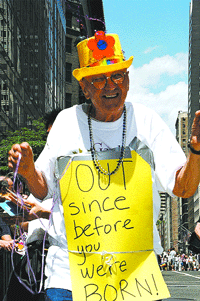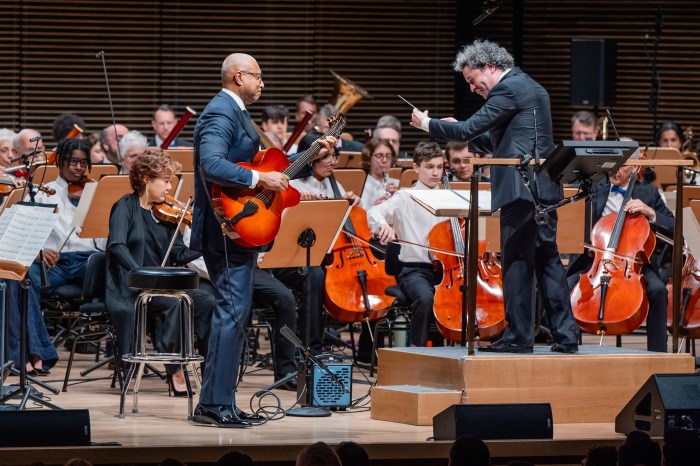Fifth Avenue lavender line becomes a trip down Memory Lane
For the 35th anniversary of Stonewall, gay, lesbian, and transgender activists led the New York Heritage of Pride parade, some with many more than 35 years of experience in the movement, some whose activism was born at Stonewall, and others who formed and joined the groups founded in early years after the rebellion. Riding on two flatbed trucks marked “Veterans of Stonewall and Early Activists” near the front of the march, these legends were cheered by thousands, even if most in the crowd did not know them by name.
Three of the most distinguished activists of all time sat in the front of the first float, a veritable Mount Rushmore of movement icons.
Frank Kameny has been fighting for gay rights since the late 1950s. He founded the Washington Mattachine Society in 1961 with Jack Nichols. They were joined Sunday by Dr. George Weinberg, the heterosexual author of the groundbreaking 1972 “Society and the Healthy Homosexual” who coined the word “homophobia.”
Kameny, with Barbara Gittings and Bruce Voeller, succeeded in pressing the American Psychiatric Association to remove homosexuality from the index of mental disorders in 1973. Nichols has chronicled the struggle in numerous books and into the 21st century for GayToday.badpuppy.com
“I’m here today to represent all my friends who couldn’t be here,” said Weinberg, echoing the sentiments of many on the floats, remembering fallen comrades. “I’m happy about our successes, but we have to be vigilant.”
Kameny, who wrote the repeal of D.C.’s sodomy law among his many accomplishments, sees “the two current unresolved issues as eliminating the ban on gays in the military and securing marriage.”
Nichols said, “I want to see the elimination of machismo.”
Also on the floats were a sometimes uneasy mix of those who had fought at Stonewall, some of whom went on to form the radical multi-issue Gay Liberation Front that burned out after two years, and others who split off and established the one-issue Gay Activists Alliance that flourished in the early 1970s and took a decade to peter out.
Doric Wilson, the gay theater pioneer and activist, said, “I’ve been fighting tears the whole trip down the avenue,” remembering working with the late Vito Russo on the first Christopher Street Liberation Day march in 1970 commemorating Stonewall. They didn’t figure on more than a few hardcore activists showing up and ended up with thousands in Central Park that day.
Randy Wicker, a gay activist since 1958, was holding up a sign for his latest cause—human cloning—and grateful the march was “recognizing people who laid the groundwork for Stonewall.”
Bob Kohler was at Stonewall and is still on the front lines, encouraging the community to join the big anti-war march on August 29.
“I have mixed emotions,” he said Sunday. “It’s a very apolitical march. Half of these people I didn’t like 40 years ago and they probably didn’t like me.”
Agosto Machado, wearing a GAA T-shirt, co-founded the Firehouse, GAA’s headquarters on Wooster St. and the precursor of the present-day LGBT Community Center.
Steve Turtell, who just hosted a forum on Stonewall at the New York Historical Society, founded Gay People of Brooklyn College and sponsored the first gay dance at a CUNY college in 1971.
Michael Shernoff, a safe sex education pioneer, became a gay activist in 1971 in college.
“I’m concerned that for a lot of gay people this is just a circuit party and don’t realize that if there hadn’t been a movement, there would be no circuit parties,” he said.
Tony Coron, now 62, recalls Stonewall as “the night I decided to become an activist. I realized gay people were no longer ‘them’ but ‘us.’”
Dick Leitsch, who was New York Mattachine’s president from 1965 through 1972, said that at the first gay pride march, he and his best friend, Ed Yeatts, went to the top of the Empire State Building to view the long gay line.
“I remember when you were the only queer in New York,” Yeatts said to him.
Marc Rubin, founder of the Gay Teachers, sat with his partner, Steve Fisher, author of “The Gay Mystique” (1972). Lew Todd, an early GAA member, said, “We’re still standing,” from his chair. Steve Ashkinazy, said that people were thanking them for paving the way for same-sex marriage, “but we were against it in GAA.” Reminded that his group took over the city’s marriage bureau in 1971, Ashkinazy said, “We were just trying to cause trouble.”
Arnie Kantrowitz, a GAA leader and author of “Under the Rainbow” about that era, sat with his longtime partner, Dr. Larry Mass, the first to write about the emerging AIDS epidemic in 1981. Fred Goldhaber, who once marched with a bag over his head because he feared losing his teaching job, became the first teacher at the Harvey Milk School in 1985. Mark Segal, 53, founded Gay Youth of NY as a cell of GLF and remembers zapping Johnny Carson, Walter Cronkite, and Barbara Walters over gay issues.
There were few women on these floats, so Joyce Hunter, 65, who founded Lesbians Rising at Hunter College in the ‘70s and went on to do pioneering work at the Hetrick-Martin Institute, invoked early lesbian activists like Sidney Abbot, Ginny Vida, Jean O’Leary, Betty Santoro, and Ginny Apuzzo. Joe Kennedy of GAA remembered members who have died like Morty Manford, Jimmy Owles, Marty Robinson, and John Paul Hudson.
Rich Wandel, also there at the first march, now preserves that early history at the Community Center’s National History Archive. Bruce-Michael Gelbert, now 53, marched alongside in his 34th march. He joined GAA when he was 20.
Allen Roskoff, also a GAA vet, called the day “glorious,” but lamented, “As we’ve become bigger, we’ve gotten more moderate.”



































